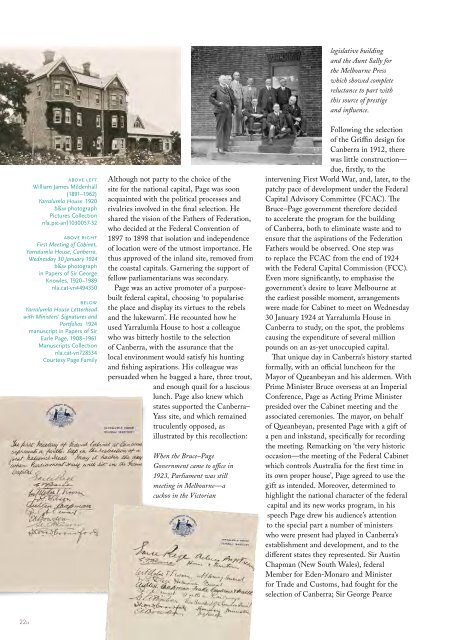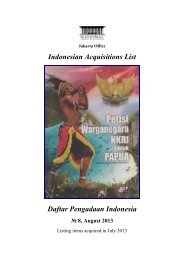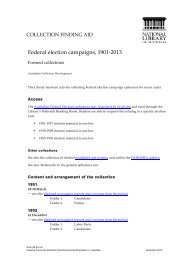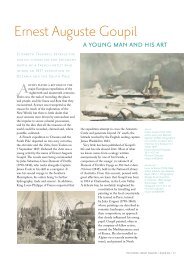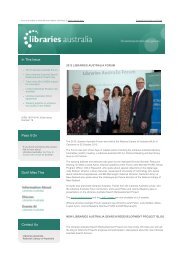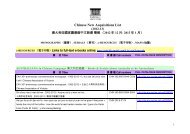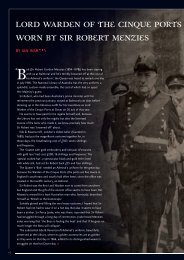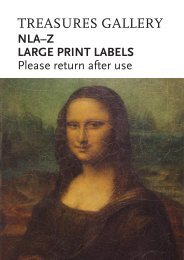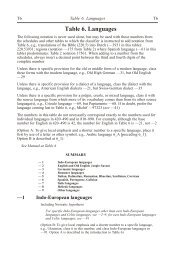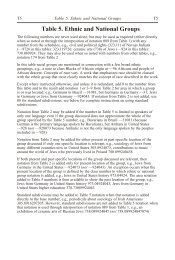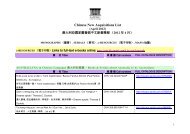Download the National Library Magazine - National Library of ...
Download the National Library Magazine - National Library of ...
Download the National Library Magazine - National Library of ...
You also want an ePaper? Increase the reach of your titles
YUMPU automatically turns print PDFs into web optimized ePapers that Google loves.
above left<br />
William James Mildenhall<br />
(1891–1962)<br />
Yarralumla House 1920<br />
b&w photograph<br />
Pictures Collection<br />
nla.pic-an11030057-32<br />
above right<br />
First Meeting <strong>of</strong> Cabinet,<br />
Yarralumla House, Canberra,<br />
Wednesday 30 January 1924<br />
b&w photograph<br />
in Papers <strong>of</strong> Sir George<br />
Knowles, 1920–1989<br />
nla.cat-vn4494350<br />
below<br />
Yarralumla House Letterhead<br />
with Ministers’ Signatures and<br />
Portfolios 1924<br />
manuscript in Papers <strong>of</strong> Sir<br />
Earle Page, 1908–1961<br />
Manuscripts Collection<br />
nla.cat-vn728534<br />
Courtesy Page Family<br />
Although not party to <strong>the</strong> choice <strong>of</strong> <strong>the</strong><br />
site for <strong>the</strong> national capital, Page was soon<br />
acquainted with <strong>the</strong> political processes and<br />
rivalries involved in <strong>the</strong> final selection. He<br />
shared <strong>the</strong> vision <strong>of</strong> <strong>the</strong> Fa<strong>the</strong>rs <strong>of</strong> Federation,<br />
who decided at <strong>the</strong> Federal Convention <strong>of</strong><br />
1897 to 1898 that isolation and independence<br />
<strong>of</strong> location were <strong>of</strong> <strong>the</strong> utmost importance. He<br />
thus approved <strong>of</strong> <strong>the</strong> inland site, removed from<br />
<strong>the</strong> coastal capitals. Garnering <strong>the</strong> support <strong>of</strong><br />
fellow parliamentarians was secondary.<br />
Page was an active promoter <strong>of</strong> a purposebuilt<br />
federal capital, choosing ‘to popularise<br />
<strong>the</strong> place and display its virtues to <strong>the</strong> rebels<br />
and <strong>the</strong> lukewarm’. He recounted how he<br />
used Yarralumla House to host a colleague<br />
who was bitterly hostile to <strong>the</strong> selection<br />
<strong>of</strong> Canberra, with <strong>the</strong> assurance that <strong>the</strong><br />
local environment would satisfy his hunting<br />
and fishing aspirations. His colleague was<br />
persuaded when he bagged a hare, three trout,<br />
and enough quail for a luscious<br />
lunch. Page also knew which<br />
states supported <strong>the</strong> Canberra–<br />
Yass site, and which remained<br />
truculently opposed, as<br />
illustrated by this recollection:<br />
When <strong>the</strong> Bruce–Page<br />
Government came to <strong>of</strong>fice in<br />
1923, Parliament was still<br />
meeting in Melbourne—a<br />
cuckoo in <strong>the</strong> Victorian<br />
legislative building<br />
and <strong>the</strong> Aunt Sally for<br />
<strong>the</strong> Melbourne Press<br />
which showed complete<br />
reluctance to part with<br />
this source <strong>of</strong> prestige<br />
and influence.<br />
Following <strong>the</strong> selection<br />
<strong>of</strong> <strong>the</strong> Griffin design for<br />
Canberra in 1912, <strong>the</strong>re<br />
was little construction—<br />
due, firstly, to <strong>the</strong><br />
intervening First World War, and, later, to <strong>the</strong><br />
patchy pace <strong>of</strong> development under <strong>the</strong> Federal<br />
Capital Advisory Committee (FCAC). The<br />
Bruce–Page government <strong>the</strong>refore decided<br />
to accelerate <strong>the</strong> program for <strong>the</strong> building<br />
<strong>of</strong> Canberra, both to eliminate waste and to<br />
ensure that <strong>the</strong> aspirations <strong>of</strong> <strong>the</strong> Federation<br />
Fa<strong>the</strong>rs would be observed. One step was<br />
to replace <strong>the</strong> FCAC from <strong>the</strong> end <strong>of</strong> 1924<br />
with <strong>the</strong> Federal Capital Commission (FCC).<br />
Even more significantly, to emphasise <strong>the</strong><br />
government’s desire to leave Melbourne at<br />
<strong>the</strong> earliest possible moment, arrangements<br />
were made for Cabinet to meet on Wednesday<br />
30 January 1924 at Yarralumla House in<br />
Canberra to study, on <strong>the</strong> spot, <strong>the</strong> problems<br />
causing <strong>the</strong> expenditure <strong>of</strong> several million<br />
pounds on an as-yet unoccupied capital.<br />
That unique day in Canberra’s history started<br />
formally, with an <strong>of</strong>ficial luncheon for <strong>the</strong><br />
Mayor <strong>of</strong> Queanbeyan and his aldermen. With<br />
Prime Minister Bruce overseas at an Imperial<br />
Conference, Page as Acting Prime Minister<br />
presided over <strong>the</strong> Cabinet meeting and <strong>the</strong><br />
associated ceremonies. The mayor, on behalf<br />
<strong>of</strong> Queanbeyan, presented Page with a gift <strong>of</strong><br />
a pen and inkstand, specifically for recording<br />
<strong>the</strong> meeting. Remarking on ‘<strong>the</strong> very historic<br />
occasion—<strong>the</strong> meeting <strong>of</strong> <strong>the</strong> Federal Cabinet<br />
which controls Australia for <strong>the</strong> first time in<br />
its own proper house’, Page agreed to use <strong>the</strong><br />
gift as intended. Moreover, determined to<br />
highlight <strong>the</strong> national character <strong>of</strong> <strong>the</strong> federal<br />
capital and its new works program, in his<br />
speech Page drew his audience’s attention<br />
to <strong>the</strong> special part a number <strong>of</strong> ministers<br />
who were present had played in Canberra’s<br />
establishment and development, and to <strong>the</strong><br />
different states <strong>the</strong>y represented. Sir Austin<br />
Chapman (New South Wales), federal<br />
Member for Eden-Monaro and Minister<br />
for Trade and Customs, had fought for <strong>the</strong><br />
selection <strong>of</strong> Canberra; Sir George Pearce<br />
22::


